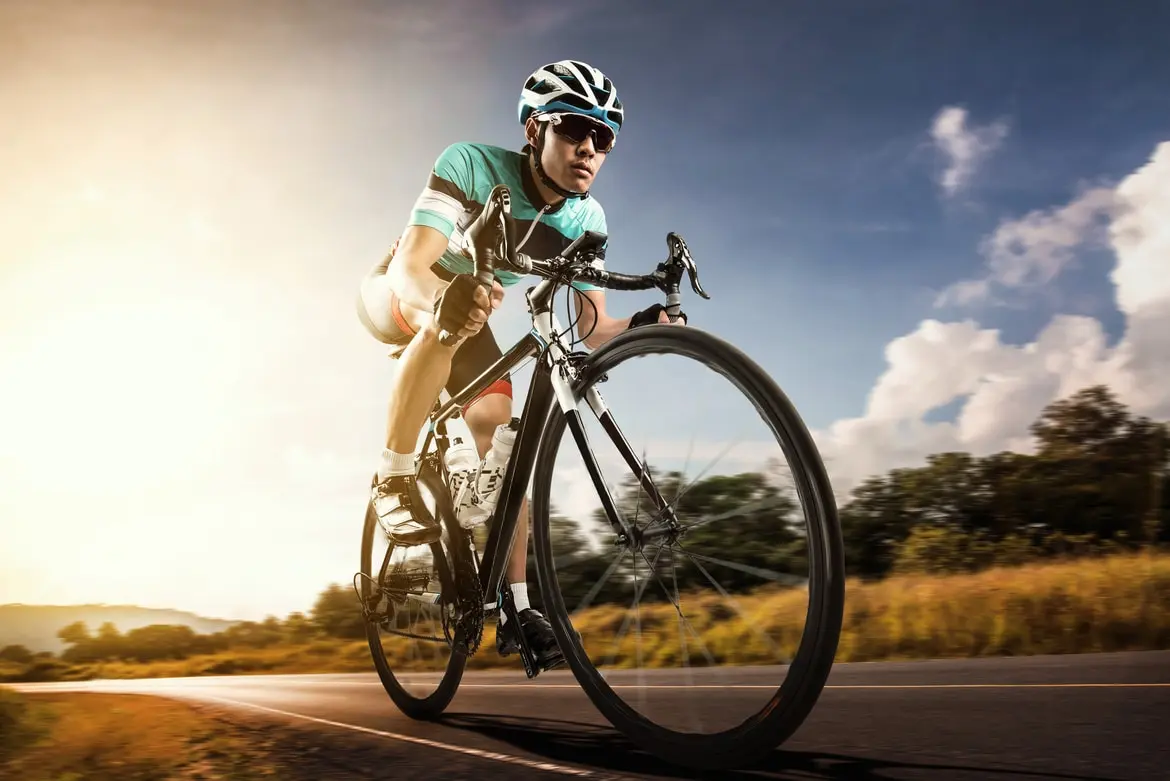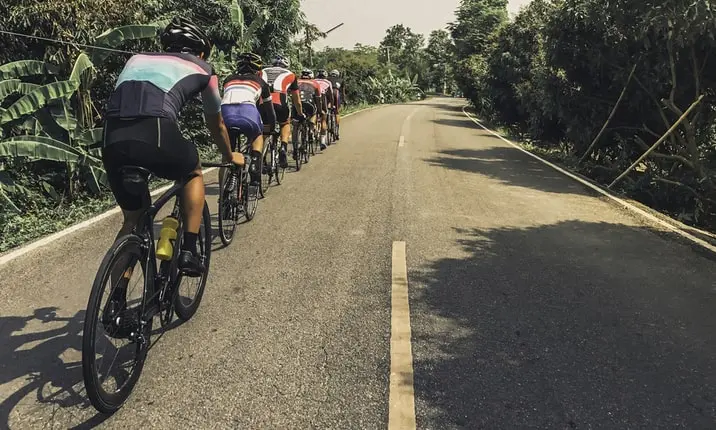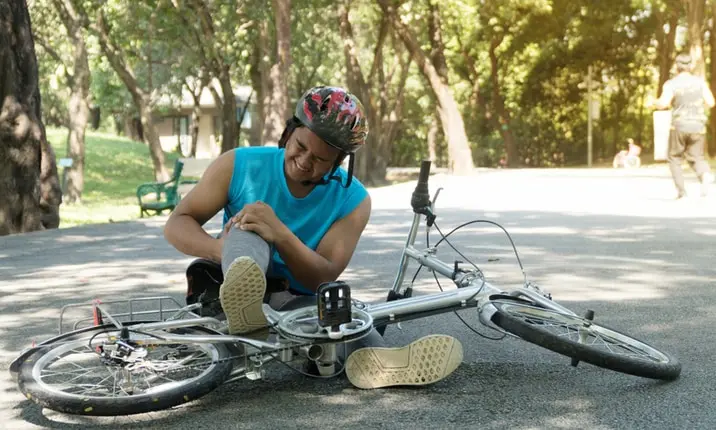

Source: Shutterstock
How to Prevent Common Cycling Mishaps
Last updated: Thursday, January 28, 2021 | 5 min reading time
What are some common cycling accidents and how can you prevent them?
Besides experiencing the rush of adrenaline and blood coursing through your veins, road cycling and mountain biking can bring about a host of health benefits.
However, as gratifying as cycling may be, accidents can happen while you're on the saddle – often in a blink of an eye. Here's a list of common cycling mishaps and how best to avoid them.
Peloton crash
Weekend after weekend, you and your road warrior buddies awake before the crack of dawn for a cross-country ride. Your tight pack oozes peloton (a group of cyclists) pride as it zips across Singapore. But as much as peloton cycling presents a number of advantages – such as helping cyclists conserve energy by reducing wind drag (resistance) and covering more ground in the same amount of time – the risk of a peloton crash is higher due to the close proximity of cyclists.
Peloton crashes are usually caused by accidental contact between cyclists, and may result in severe injuries. As a cyclist falls, a domino effect is created, and this commonly leads to broken collar bones, femurs, and concussions.
So how can you avoid peloton crashes?
Cyclists should first be comfortable with drafting other riders (and allowing others to draft him or her) before riding in a peloton. If the pack consists of experienced and less experienced riders, cyclists should start cycling in a single line with a distance of 1 – 2 metres between riders. As the pack becomes more comfortable with drafting, that distance can progressively be minimised. Stronger riders should ride farther front in the pack as they will experience more drag than those behind.
To manage the expectations of each cyclist and avoid haphazard overtaking, positional rotations among cyclists should be planned before the ride.
Skids and falls on slopes
You love hill work because riding up those slopes brings you close to your maximum heart rate and that makes you feel more alive than ever. One of your favourite pastimes is cycling endless loops up and down Mount Faber.
Hill work is undoubtedly exhilarating – and great for cardiovascular endurance. But fatigue, a momentary lapse in concentration (especially when freewheeling downhill), or cycling on wet, slippery slopes, may cause skidding and serious falls that result in severe cuts and abrasions.
How to avoid skids and falls on slopes
You can still hit the slopes while taking necessary precautions to prevent injury and climb effectively.
- Cyclists should remain seated for most of the climb. This gives you better control of the bike and trains the muscular endurance of your lower limbs.
- Stand in the attack position (hands on hoods, body crouched) only during the steepest parts.
- While seated, slide back in the saddle for better leg extension and leverage.
- If you're tired, shift to a lower gear but keep your cadence steady.
Here are some suggestions to stay safe while going downhill.
- Cyclists should ride in the drops. This lowers your centre of gravity and helps you maintain stability. Your weight will also be better distributed between the front and rear wheels, which improves traction.
- Riders should also always scan ahead to be aware of the surroundings and anticipate what to do next. This eliminates sudden braking, which may cause a drastic forward fall.
Hitting a pothole
Potholes – they're hard to detect and the bane of every cyclist's existence. A UK survey found that more than 56% of Britons would cycle more if the road had fewer potholes. Although potholes in Singapore are not as common an occurrence as in the UK, given that repairs are consistently being done on almost every alternate road on this little island, it would be wise for cyclists to be on a constant lookout for those dreaded pits in the road.
The most common injuries cyclists sustain from hitting a pothole are dislocated shoulders or elbows, as it's almost instinctive that one would use his or her hand or arm to break a forward fall.
A good way to prevent falling victim to a pothole is to habitually scan the road ahead for dark patches while cycling and carefully avoiding them. Daydreaming on the saddles, on the other hand, may land you (and your cycling buddies) in a hospital's UCC.
How to prepare for a small pothole
Sometimes, you may be unable to avoid a small pothole. In this circumstance, the best approach is to relax your grip on the handle bars slightly, lift your weight out of the saddle and allow the bike to bump over the depression.
Try to remain relaxed as you go over the pothole and allow your arms and legs to absorb the impact. If the recess is too deep and you're clipped to the pedals, try to bunny-hop over it by simultaneously pulling on the bars and pedals. Bunny-hopping your bike, of course, requires prior practice.
Attacked by wildlife
It may sound amusing, but reports of wildlife sightings (and attacks, in some cases) by mountain bike (MTB) enthusiasts in Singapore have been on the rise. This comes as no surprise as most of the MTB trails are located among the island's lush greenery, which is also home to monkeys, wild boars, and pangolins.
These creatures are usually not hostile and attacks are uncommon, but in the event that you encounter an animal having a bad day, you may end up with some bites and scratches.
According to the Agri-Food and Veterinary Authority of Singapore (AVA), the best approach when encountering wildlife is to not approach them at all. If a face-to-face situation is inevitable, back away slowly and refrain from antagonising the local fauna. Before heading out to an MTB trail, you should also familiarise yourself with the different types of animals and their characteristics found on AVA's website.
Recovering from an injury
If you sustain minor sprains or strains while cycling, go for the RICE (rest, ice, compression and elevation) method as one of your first treatments. It's an effective, no-fuss self-care technique that will reduce inflammation, alleviate pain and promote healing. The RICE method can also be used to treat small bruises.
For minor cuts, the bleeding usually stops on its own. If it doesn't, use a clean cloth or gauze and apply firm and direct pressure to the wound and hold the pressure firmly. Thereafter, clean the wound as soon as possible by placing it under cool running water. After ensuring that all dirt and debris has been removed from the wound, you may consider applying a thin layer of antibiotic ointment before covering the wound with a sterile dressing.
If you sustain more serious injuries but you're still conscious and able to make your own way to the hospital, call these hotlines for help:
Mount Elizabeth Orchard 24-Hour UCC Helpline: +65 6731 2218
Mount Elizabeth Novena 24-Hour UCC Helpline: +65 6933 0100
During a medical emergency in Singapore, you can also call +65 6473 2222 for an ambulance that will transport you to the nearest hospital or a hospital of your choice. Learn more about Parkway Emergency services.
Brady, P. (n.d.). Group riding skills. Peloton Magazine. Retrieved from https://pelotonmagazine.com/wisdom/group-riding-skills/
Brady, P. (2011). The no-drop zone: Everything you need to know about the peloton, your gear and riding strong. Birmingham, AL: Menasha Ridge Press
Cyclists' guide to dealing with potholes. (2017, October 10). Cycling Weekly. Retrieved from http://www.cyclingweekly.com/fitness/training/cyclists-guide-to-dealing-with-potholes-139074
Lindsey, J. (2011, March 23). Cycling skills: Climb smarter. Bicycling. Retrieved from https://www.bicycling.com/training/a20004196/cycling-training-tips-climb-faster/
Lorries and potholes put people off cycling, survey suggests. (2018, June 1). BBC. Retrieved from https://www.bbc.co.uk/news/uk-44317672
Stieda, A. (2010, May 1). Cycling tips: Descending hills. Bicycling. Retrieved from https://www.bicycling.com/training/a20012974/cycling-tips-descending-hills/
Tatarsky, D. (2017). The splendid book of the bicycle. Princeton, NJ: Portico
Yang, C. (2017, April 18). AVA received some 160 complaints on monkey attacks and nuisance in Segar area in Bukit Panjang. The Straits Times. Retrieved from https://www.straitstimes.com/singapore/environment/ava-received-some-160-feedback-on-monkey-attacks-and-nuisance-in-segar-area-in
Yeager, S. (2017, March 14). 7 reasons why cycling is better than running. Bicycling. Retrieved from https://www.bicycling.com/news/a20028021/7-reasons-why-cycling-is-better-than-running/
Brady, P. (2011). The no-drop zone: Everything you need to know about the peloton, your gear and riding strong. Birmingham, AL: Menasha Ridge Press
Cyclists' guide to dealing with potholes. (2017, October 10). Cycling Weekly. Retrieved from http://www.cyclingweekly.com/fitness/training/cyclists-guide-to-dealing-with-potholes-139074
Lindsey, J. (2011, March 23). Cycling skills: Climb smarter. Bicycling. Retrieved from https://www.bicycling.com/training/a20004196/cycling-training-tips-climb-faster/
Lorries and potholes put people off cycling, survey suggests. (2018, June 1). BBC. Retrieved from https://www.bbc.co.uk/news/uk-44317672
Stieda, A. (2010, May 1). Cycling tips: Descending hills. Bicycling. Retrieved from https://www.bicycling.com/training/a20012974/cycling-tips-descending-hills/
Tatarsky, D. (2017). The splendid book of the bicycle. Princeton, NJ: Portico
Yang, C. (2017, April 18). AVA received some 160 complaints on monkey attacks and nuisance in Segar area in Bukit Panjang. The Straits Times. Retrieved from https://www.straitstimes.com/singapore/environment/ava-received-some-160-feedback-on-monkey-attacks-and-nuisance-in-segar-area-in
Yeager, S. (2017, March 14). 7 reasons why cycling is better than running. Bicycling. Retrieved from https://www.bicycling.com/news/a20028021/7-reasons-why-cycling-is-better-than-running/
 Brain & Spine Care
Brain & Spine Care












